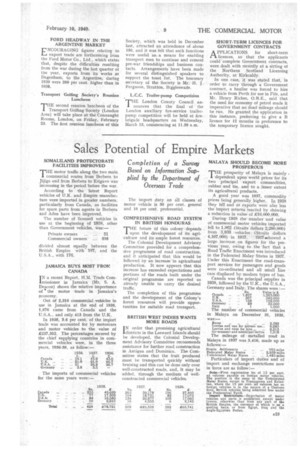Sales Potential of Empire Markets
Page 25

If you've noticed an error in this article please click here to report it so we can fix it.
Completion of a Survey Based on Information Supplied by the . Department of Overseas Trade
SOMALILAND PROTECTORATE FACILITIES IMPROVED
THE motor traffic along the two main commercial routes from Berbera to Jijiga and from Berbera to Erigavo was increasing in the period before the war.
According to the latest Report vehicles of U.K. and Empire manufacture were imported in greater numbers, particularly from Canada, as facilities for spare parts from agents in Berbera and Aden have been improved.
The number of licensed vehicles in use at the beginning of 1938, other than Government vehicles, was:—
Private owners ... 51 Commercial owners 316 divided almost equally between the British Empire with 187, and the U.S.A., with 176.
JAMAICA BUYS MOST FROM CANADA
I N a recent Report, H.M. Trade Com missioner in Jamaica (Mr. S. A. Deacon) shows the relative importance of • the motor trade in Jamaica's economy.
Out of 2,316 commercial vehicles in use in Jamaica at the end of 1938, 1,876 came from Canada and the U.S.A., and only 413 from the U.K.
In 1938, 3.6 per cent, of the imPort trade was accounted for by motorcars and motor vehicles to the value of £237,352. The percentages secured by the chief supplying countries in commercial vehicles were, in the three years, 1936-38, as follow:— The import duty on all classes of motor vehicle is 30 per cent, general and 10 per cent. preferential.
COMPREHENSIVE ROAD SYSTEM IN BRITISH HONDURAS
THE future of this colony depends upon the development of its agriculture and its ample forest resources.
The Colonial Development Advisory Committee provided for a comprehensive programme of road construction, and it anticipated that this would be followed by an increase 'in agricultural production. It now appears that this increase has exceeded expectations and portions of the roads built under the original programme are reported as already unable to carry the desired traffic.
The completion of this programme and the development of the Colony's forest resources will provide opportunities for suitable road transport.
BRITISH WEST INDIES WANTS MORE ROADS I N order that promising agricultural
districts in the Leeward Islands should be developed, the Colonial Development Advisory Committee recommends assistance for further road construction in Antigua and Dominica. The Committee states that the fruit produced must be transported quickly without bruising and this can be done only over well-constructed roads, and, it may be added, through the medium of wellconstructed commercial vehicles.
MALAYA SHOULD BECOME MORE PROSPEROUS THE prosperity of Malaya is mainly _ dependent upon world prices for its two principal export commodities, rubber and tin, and to a lesser extent its agricultural products.
A good year was 1937, commodity prices being generally higher. In 1938 they fell and as .exports were also less the import returns reacted by showing a reduction in value of £16,000,009, During1938 the number 'and value of commercial motor vehicles imported fell to 1,962.(Straits dollars 2,290,000) from 3,939 vehicles (Straits dollars
4,107,000) in 1937. 10374nhowed a large increase on figures for the previous—year, owing to the 'fact that a Road Traffic Enactment was introduced in the Federated Malay States in 1937. Under this Enactment the road-transport services for passengers and goods were co-ordinated and all small Eire cars displaced by-modern types of bus.
Canada was the principal supplier in 1938, followed by the U.K., the U.S.A., Germany and Italy. The shares were :— The number of commercial vehicles in Malaya on December, 31, 1938, was:—
Buseses 2,392
'Lorries an can for Private use— 6,285
Buseses 2,392
'Lorries an can for Private use— 6,285 Lorries and vans for hire ... 2,313 Go-ernment and municipal lorries 1,318
The mileage of metalled road in Malaya in 1937 was 5,416, made up as follows:— Straits Settlements ... 992 miles
Federated Malay States . • .. 2,939 miles
, Tinfederated Ma-lay States 1,485 miles
Particulars of import duties and of import and exchange restrictions now in force are as follow:
Duty.—First registration fee of 15 per cent. ad valorem payable on foreign motor vehicles. The pomtion is the same in the Unfederated Malay States, except in Tranggannu and Kelantan, where the 15 per cent. ad valorem tax on foreign vehicles it in the nature of a Customs duty, British vehicles being admitted free under the Preferential Tariff.
Import Restriotions.—importation of motor vehicles and parts is prohibited, except under licence, otherwise than from any part of the British Empire, the currency of which is on a skerlinc basis, or from Egypt, Irag and the Anglo-Egypt.= Sudan.




























































